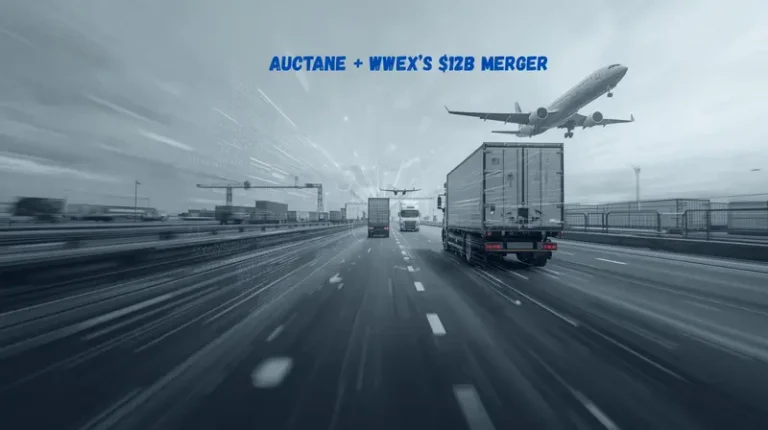The Hidden Costs of Disconnected Operations

Last updated on July 09, 2025

In this article
 14 minutes
14 minutes
- The Patchwork Trap: How We Got Here
- 1. Productivity Black Holes
- 2. Customer Experience Clunks (and the Revenue Hits You Don’t See)
- 3. Higher Operational Costs (Death by a Thousand Apps)
- 4. Stunted Growth and Agility
- So, What’s the Fix? (The Light at the End of the Silo)
- Final Thoughts
- Frequently Asked Questions
Most brands don’t set out intending to build a convoluted operations stack; it just happens. You start selling online and add a tool here, and a platform there: one for order fulfillment, another for shipping labels, yet another for returns processing. Each piece might work fine on its own, so you assume all is well. Spoiler alert: It’s not. Those disconnected operations are quietly draining your resources and choking your growth. The fragmentation is sneaky; the costs show up in ways you might not immediately tie back to your patchwork of systems. Today, let’s pull back the curtain on the hidden costs of disconnected operations in ecommerce and logistics. If you’re an ecommerce operator, brand owner, or logistics manager, this one’s for you, because running your business shouldn’t feel like herding cats across five different software platforms.
The Patchwork Trap: How We Got Here
First, a little empathy, you’re not dumb if your ops are disconnected; you’re normal. Most brands evolve this way: you pick the “best” tool for each job as it arises. A shipping app here, a warehouse management system there, and a returns portal later on. Each promises to solve one specific pain point. And individually, they often do. The problem is what happens between those tools, or rather, what doesn’t happen. They don’t talk to each other well (if at all). You end up with data silos and manual processes to bridge gaps. It’s like having a team where each member speaks a different language and there’s no translator. Inevitably, stuff gets lost in translation.
On the surface, you might not notice the cracks immediately. Orders still get out the door, customers still get tracking numbers, and returns still get processed eventually. But behind the scenes, you’re working harder and spending more to compensate for the disconnection. Let’s dig into those hidden costs one by one; you might recognize a few in your own operation.
Let AI Optimize Your Shipping and Boost Profits
Cahoot.ai software selects the best shipping option for every order—saving you time and money automatically. No Human Required.
See AI in Action1. Productivity Black Holes
One of the first casualties of disjointed systems is your team’s productivity. Think about how much time is wasted on tasks that should be automated or at least streamlined:
- Duplicate Data Entry: Your warehouse team prints orders from System A, then manually types them into Shipping System B to get labels. Later, they might update an inventory count in System C. It’s 2025, why are we still playing secretary between systems? This double or triple work not only eats up hours, but it also introduces errors. Humans aren’t great at mindless copy-paste jobs; inevitably, a “10” becomes a “100” somewhere, or an address gets misspelled.
- Swivel Chair Operations: Ever feel like your day is Alt-Tab, Alt-Tab, Alt-Tab? That’s the “swivel chair” effect, moving between screens because info lives in different places. Need to answer a simple customer question like “Hey, did my return get processed?” You have to check the ecommerce platform for the order, the returns system for the RMA status, and the warehouse system to see if the item is in stock. Three logins later, you have an answer (hopefully). Multiply that by dozens of inquiries and tasks, and it’s death by a thousand clicks.
- Training and Onboarding Overhead: Each additional system is an additional skill set that new employees must learn. Your SOP document starts to look like a phone book. Onboarding a new hire to your ops team becomes a month-long saga (“First, learn Tool X. Then Tool Y. Don’t mix them up. Here’s how to export from X to import to Y…”). And every system has its quirks; your poor Ops Manager has to become the in-house expert on 5 different UIs and workflows. That’s mentally draining and frankly not what they signed up for.
These productivity hits are often unmeasured. No one writes “spent 2 hours reconciling spreadsheets between systems” on a timesheet. But it’s happening. Fragmented workflows = friction = slower operations. And in ecommerce, slow is deadly. Which brings us to the next cost…
2. Customer Experience Clunks (and the Revenue Hits You Don’t See)
Your customers experience the results of your operations, whether you like it or not. When systems aren’t in sync, customers feel it:
- Shipping Delays & Surprises: Say your inventory system and your website aren’t perfectly synced (not a far-fetched scenario in disconnected land). A customer orders an item that shows in stock online, but in reality, it’s out of stock in the warehouse because the update lagged. Now you have to scramble to either rush stock or notify the customer. Either way, the customer’s confidence in you just took a hit. Or perhaps you shipped from the wrong location because your order system didn’t communicate that the East Coast warehouse was out of units, but the West Coast had plenty. Now the delivery takes a week longer and the shipping costs you twice what it should have.
- Returns Black Box: From the customer’s side, returns can be the most anxiety-inducing part of ecommerce. They send the item back and then… wait. If your returns system isn’t integrated with your customer communication, the customer might be left in the dark (“Did they get my package? When will I see the refund?”). I’ve seen cases where the left hand (returns dept) processed a refund, but the right hand (customer support) didn’t know because the systems were separate, so support gave incorrect info or failed to reassure the customer in a timely way. A confused, unhappy customer = lost future sales. Maybe they’ll forgive a one-off glitch, but if every interaction with your brand feels a bit clunky, they won’t stick around.
- Omnichannel Oops: These days, customers might interact with you on multiple channels (marketplaces, your own site, maybe even brick-and-mortar). If each channel’s operations are siloed, customers can’t get a unified experience. For example, they bought on your Shopify site but want to return to your store. Can your systems handle that seamlessly? Or a customer calls customer service about an Amazon order, can your rep see that order in the same system as DTC orders? If not, cue the awkward “Uh, hold on while I look that up in another system…” Not professional. Disconnected ops often lead to disconnected customer experiences, and customers can sense when your left hand doesn’t know what the right is doing. It erodes trust and loyalty.
The scary thing is, the revenue impact of these CX issues is hard to quantify, but very real. Maybe it’s increased cart abandonment (because your delivery estimates are slow or stockouts frequent). Maybe it’s higher return rates (because, say, product info wasn’t consistent across channels). Or it’s simply lost lifetime value when customers quietly slip away to competitors who offer a smoother ride. You might not see an immediate bill for these costs, but they show up in softer metrics like customer lifetime value, repeat purchase rate, and even your ad spend efficiency (if you’re having to reacquire lapsed customers). In short, fragmentation can make your brand look bigger (in a bad way) or less competent than you actually are.
Looking for a New 3PL? Start with this Free RFP Template
Cut weeks off your selection process. Avoid pitfalls. Get the only 3PL RFP checklist built for ecommerce brands, absolutely free.
Get My Free 3PL RFP3. Higher Operational Costs (Death by a Thousand Apps)
Now let’s talk dollars and cents on the ops side. Running multiple disconnected tools often means you’re paying for overlapping functionality or not leveraging economies of scale:
- Multiple Subscriptions & Vendors: Obviously, more tools = more subscriptions or licenses. You might be paying for 3 different platforms where a single integrated platform could do it all (or at least a big chunk) for a better-bundled rate. Or perhaps you started on a bunch of cheap apps, but as volume grew, you had to upgrade each one to higher tiers. Suddenly your monthly SaaS bill is looking scary. I’ve seen small brands where the combined cost of all their point solutions was higher than if they had just invested in one robust system from the get-go.
- Maintenance and IT Overhead: With separate systems, you either live with minimal integration or you bolt things together with custom code, plugins, zaps, etc. Maintaining those connectors can become a nightmare. Every update to one system risks breaking the link. Maybe you even hire a developer or IT consultant to set up APIs between systems, that’s an added cost and complexity. And what if something breaks? Pinpointing where an error occurred in a daisy chain of software is not fun (everyone points fingers: “Must be the API”, “No, our system is fine, it’s the other one”). Meanwhile, orders might be stuck in limbo while troubleshooting happens, yikes.
- Inventory and Stock Inefficiencies: This one’s a bit more subtle, but disconnected ops often mean poorer inventory visibility. You might err on the side of caution and hold more safety stock because you aren’t confident in the numbers you see from system A vs system B. Or you don’t reposition inventory to the optimal location because you lack a unified view. That ties up capital in excess stock or leads to missed sales on out-of-stocks. Both are costly. Better integration tends to enable leaner inventory management, something all retailers crave.
- Human Firefighting = $$: All those productivity black holes and manual fixes we mentioned? That often translates to needing more staff than otherwise. If one integrated system could handle the workload of two disconnected ones, you might avoid hiring an extra ops coordinator whose main job becomes babysitting the gaps. Or your current team could focus on value-add activities (like negotiating better shipping rates, analyzing sales trends, and improving processes) instead of playing human middleware. People’s time is money. You’re either directly paying more salaries, or you’re paying in opportunity cost because your talented team is stuck in the weeds.
4. Stunted Growth and Agility
Perhaps the most pernicious cost is the opportunity cost of what you can’t do because your operations are too fragmented to support it. In a fast-moving ecommerce market, agility is gold. Disconnected systems make you less agile:
- Expanding to New Channels or Markets: Want to start selling on a new marketplace or launch a pop-up store? With an integrated ops platform, it might be as simple as flipping a switch or adding a module. But if your systems are separate, each new channel might need its own parallel process. I’ve seen businesses hold off on launching on, say, Walmart Marketplace or international expansion because it would “mess up our workflow” or require a whole new set of tools. That’s growth stifled by tech debt.
- Scaling Volume: When you’re small, manual workarounds are manageable. But if you double order volume, those cracks widen. If your operations are glued together with spreadsheets and heroics, the scale will break them. Then you’re in a crisis, trying to re-platform or integrate under pressure, which usually means downtime and mistakes. The cost here could be failing to capitalize on demand or, worse, imploding under success (not fulfilling on time, angering customers, getting bad reviews, etc., because your ops buckled).
- Data-Driven Decision Making: In the era of Big Data, disconnected ops leave you with fragmented data. It’s hard to get a single source of truth when sales are in one system, fulfillment in another, and returns in a third. So, you either don’t do robust analysis or you spend a lot of analyst hours piecing together CSV exports. That means you might miss trends like “Hey, product X has a high return rate in the Northeast, maybe it’s a shipping issue or a sizing issue specific to that region.” Or you can’t easily calculate your true customer acquisition cost vs lifetime value because the data lives in silos. Without integrated data, you’re essentially flying partially blind. The strategic missteps that can result (ordering too much stock, mispricing shipping, not noticing a surge in return fraud, etc.) have real financial impacts.
Scale Faster with the World’s First Peer-to-Peer Fulfillment Network
Tap into a nationwide network of high-performance partner warehouses — expand capacity, cut shipping costs, and reach customers 1–2 days faster.
Explore Fulfillment NetworkSo, What’s the Fix? (The Light at the End of the Silo)
Alright, enough doom and gloom. The whole point of exposing these hidden costs is so that we can tackle them. The obvious antidote is integration, ideally, a unified platform or at least a well-connected stack for fulfillment, shipping, and returns (and maybe more, like inventory and customer data).
Imagine a world where one system (or a tightly knit system) handles your order from the moment it’s placed to the moment the customer is satisfied (either keeping the product or completing a return). No more jumping between screens to update status. The inventory updates in real-time across all channels. The customer gets consistent communications. Your reports come from one database, so they’re always in sync. Sounds dreamy, right?
This isn’t just theoretical. Modern solutions (yes, including our team at Cahoot, shameless plug) are tackling exactly this problem. The philosophy is: modularity with unity. For instance, Cahoot offers fulfillment, shipping, and returns in one platform. You can start with what you need (maybe you just use the shipping software at first), but because it’s one ecosystem, adding the other pieces later is seamless. It’s like having individual puzzle pieces that perfectly snap together because they’re made as one set. You don’t have to rip out your whole tech stack on day one (“no rip-and-replace” as we say); you can gradually migrate into a unified system, alleviating pain points step by step.
The results? Those hidden costs we talked about start melting away:
- Teams reclaim the hours lost to copy-paste and platform switching, which can be refocused on growth projects or simply mean you can handle more orders with the same staff.
- Fewer errors and faster processes mean happier customers, you’ll see that in better reviews, fewer support tickets, and maybe even higher repeat purchases since everything just works smoothly.
- Operational costs come down as redundancies are eliminated (one system vs five, fewer mis-ships, lower inventory buffers, etc.).
- When opportunity knocks, a big BFCM spike, a new sales channel, whatever, you can answer with confidence because your house is in order. Your unified system scales with you; you’re not scrambling to patch up leaks.
Final Thoughts
In summary, the hidden costs of disconnected operations are very real, but they’re also avoidable. It requires an honest look at your current setup and the courage to change it. That might mean consolidating tools, investing in integration, or switching to a unified platform that’s built for modern ecommerce needs. Yes, there’s effort involved in that transition, but think of it like cleaning up a messy warehouse; once it’s done, everything flows with ease, and you wonder why you didn’t do it sooner.
At the end of the day, an ecommerce or retail brand succeeds by delivering great products and great experiences efficiently. You can’t do that when your own internal systems are fighting each other. So, don’t let disconnected operations be the silent killer of your profits and reputation. Break down those silos, connect the dots, and watch the benefits ripple through every corner of your business. Your team will thank you, your customers will thank you, and future-you (with a thriving, scalable business) will definitely thank you.
Now, over to you: Have you experienced any of these pains? Are you stuck in spreadsheet hell or juggling a few too many apps? Share your war stories or victories in integrating ops, I’d love to hear how others are navigating this journey. After all, we’re all trying to build something great without going crazy in the process. Here’s to more cohesion and less chaos!
Frequently Asked Questions
Why are disconnected operations so common in ecommerce?
Because most brands grow organically, adding new tools as problems arise. It starts with good intentions, but without a plan to integrate systems, the tech stack turns into a disjointed mess.
What are the most overlooked costs of a fragmented operations stack?
Productivity losses, training inefficiencies, higher customer service burdens, and missed revenue opportunities are the big ones. These don’t show up on a P&L, but they quietly erode profitability.
How do disconnected systems impact customer experience?
They cause slower fulfillment, inconsistent communication, and higher error rates. Customers notice when your left hand doesn’t know what the right is doing, and they often don’t come back.
What’s the ROI of consolidating ecommerce operations?
Brands that consolidate save money on software, reduce labor inefficiencies, and improve customer satisfaction. The real ROI is operational agility, being able to scale, expand, or adapt without imploding.
Do I need to rip out all my systems to fix this?
Not necessarily. Look for platforms that allow phased adoption, so you can start with one component (like shipping) and expand into a unified system over time. Think modular, but made to connect.

Turn Returns Into New Revenue





